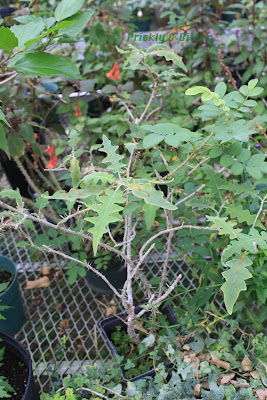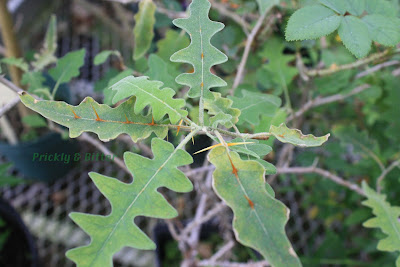BLOG UPDATE: Starting tomorrow, I will be on a long-awaited internet-less vacation until February 25th, so no blog posts during that time. I'll be back with some awesome plant pictures (and hopefully some pictures of fungi, too!) from the Dominican Republic, so expect some more tropical species when I return! I'll also go out and take some photos of sticks when I get back on a nice day and do the promised series about "winter tree identification using sticks". Cheers! Enjoy the week!
Species name: Solanum pyracanthon
Common name: porcupine tomato
Location: UWO Greenhouse
The porcupine tomato, a close relative of the edible tomato, is native to Madagascar and, like many species there, is at risk due to the enormous amount of deforestation that has occurred there. The plant is still very common in some areas where it grows like a weed, but in others (where it was once common) it is completely absent. The plant has been introduced as an ornamental species to Europe and North America where it has the ability to escape under certain circumstances (usually if planted in gardens in the southernmost regions of both continents). For most that have this plant as an ornamental, there is very little risk of it escaping because it is very frost-sensitive. It is still best, however, to make sure you pick the fruit off the bush before the seeds have a chance to disperse (the fruit really does look identical to a tomato!), as the seedlings almost immediately produce the bright orange thorns which are full of toxins and make the plant very difficult to remove.
Like most species in the tomato family (the Solanaceae), the porcupine tomato produce a class of chemicals called the tropane alkaloids which, depending on the chemical composition of these alkaloids, can prove deadly if consumed. Belladonna, Jimsonweed, henbane and mandrake are all other examples of plants with high concentrations of these tropane alkaloids. Extreme care should be exerted should you choose to grow this plant as an ornamental species; if you happen to prick yourself with a thorn and the thorn breaks in your skin, a flux of these tropane alkaloids will be released directly into your blood stream and it can make you seriously ill. It certainly won't kill you with that small amount, but flu-like symptoms are almost guaranteed. Since the fruits look so much like tomatoes, it is strongly suggested that this plant never, under any circumstances, be exposed to small children as that could have disastrous consequences; a child eating one small fruit will almost certainly die as a result.




No comments:
Post a Comment